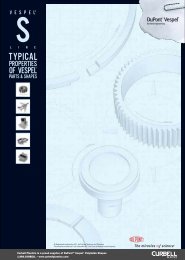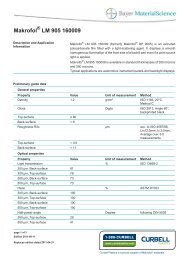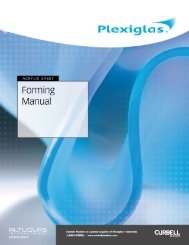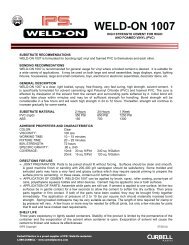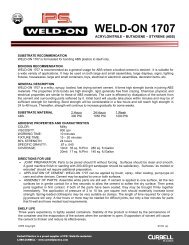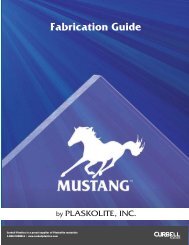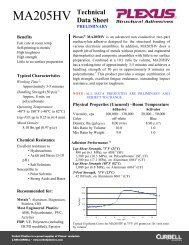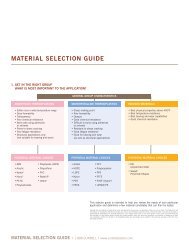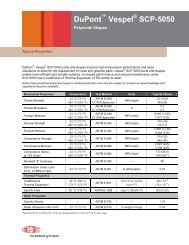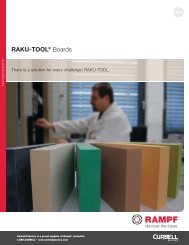Acrylite Acrylic Sheet Fabrication - Curbellplastics.com
Acrylite Acrylic Sheet Fabrication - Curbellplastics.com
Acrylite Acrylic Sheet Fabrication - Curbellplastics.com
- No tags were found...
You also want an ePaper? Increase the reach of your titles
YUMPU automatically turns print PDFs into web optimized ePapers that Google loves.
Saw Blade Dampeners/StiffenersSaw blade dampeners or stiffeners can greatly reducesaw blade vibration during saw operation. They arehighly re<strong>com</strong>mended for use when cutting acrylic sheetbecause they will usually result in improved saw cutquality and reduced noise during saw operation. (Note:Some high quality panel saws are built with large bladecollars and may not benefit from the use of a bladestiffener.) When installing a stiffener, be sure to removeall foreign material from the saw blade and mountingwashers. Any bumps or scratch-burrs on the saw bladesurface should be stoned flat to ensure even metal-tometalcontact between the stiffener and the saw blade.Best results are normally obtained by selecting astiffener ½ to 2/3 the diameter of the saw blade.CoolingThe use of a saw blade cooling system can yield amuch cleaner, smoother saw cut edge and greatlyincrease the life of the saw blade. These systemsremove heat from the blade and the plastic as it is beingcut. Two types of systems are <strong>com</strong>monly used.Compressed air or vortex tube cooled <strong>com</strong>pressed airsystems are preferred. These systems are cleaner tooperate and require little maintenance. Mist systems,which apply a water-soluble oil with rust inhibitor, alsowork well providing blade lubrication as well as cooling.However, these systems will require more maintenanceand the material may need cleaning afterwards toremove residual oil. It is also important to ensure thatthe lubricating solution is <strong>com</strong>patible with acrylic. (Seethe Equipment and Material Suppliers section forre<strong>com</strong>mended lubricants or contact CYRO’s TechnicalService Department with <strong>com</strong>patibility questions.) Whenusing a saw blade cooling system, the air or mist streamshould be lightly sprayed on the teeth of the saw bladejust before they enter the material.OperationFor table type saws or panel saws with the blademounted underneath, the blade should protrudeapproximately 1/8” to 1/2” above the work pieces. Theoptimum setting will vary with sheet thickness (seeTable 1). On overhead blade-mounted panel saws, theblade should protrude 1/32” through the material. Thesesettings should yield a smooth cut and minimize edgechipping by providing a favorable cutting angle for thecutting edge of the saw blade teeth. In general, largerblade clearances will reduce tooth engagement slightlyresulting in less heat generation and, in some situations,reduced melting while smaller blade clearances providebetter cutting and chip control resulting in less likelihoodof chipping on the bottom of the cut. Excessively lowblade clearances, often in <strong>com</strong>bination with a dull blade,can cause chipping at the top of the cut.Feed the material evenly through the saw. Uneven feedrates will produce melted spots or chipping on theplastic. Typical feed rates for ACRYLITE FF sheet are100” to 300” per minute. However, with some speciallydesigned saw blades (such as the “NO MELT” saw bladefrom Forrest Manufacturing Co.) feed rates as high as600” per minute can be used with success.When cutting on a table saw, care must be taken toensure the operators safety. Always follow theprecautions outlined in the manual provided by the sawmanufacturer and consult the saw blade supplier forre<strong>com</strong>mendations on the proper use of their saw blades.Safety precautions should also include (but are notlimited to) the following:Always wear protective safety glasses with sideshields.Ensure all guards are in place and operational.Do not wear loose fitting clothing or jewelry and tieback long hair.Ensure work area is clean and free of slip hazards.Ensure the correct saw blade is mounted for thematerial being cut.Ensure saw blade is in good condition, is properlymounted, rotates in the correct direction, is correctlyaligned, and is set at the proper height.Never place hands within four (4) inches of therotating saw blade. If small pieces must be cut thatcould require the hands to be closer, then consideralternate methods of cutting, feeding or fixturing thematerial for safer handling.Never force-feed material into the blade. If the motorslows down, the material begins to “ride-up” or ifexcessive vibration is encountered, discontinuecutting and turn off the power.Never position your body directly behind the sawblade during operation and be sure no one else isworking in the area behind the blade.Never utilize the fence for sizing cuts less than 2.0times the length of exposed saw blade. For shortercuts use a miter gauge to guide the material.Never use the miter gauge and fence together.Never draw the material backwards during cutting.Always hold the material firmly while feeding.Stop the saw frequently to clean up cutoffs andsawdust. Be sure the saw blade has stopped<strong>com</strong>pletely before cleaning. Do not attempt toremove waste while the saw is running.4



